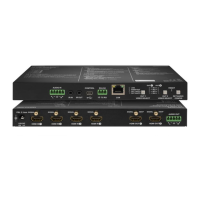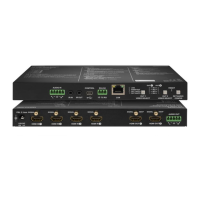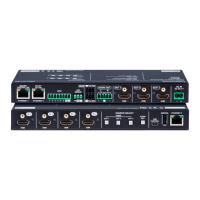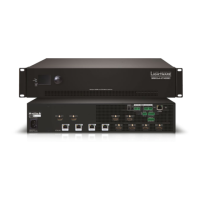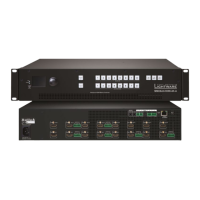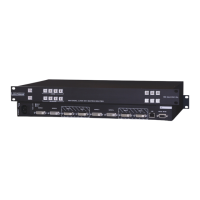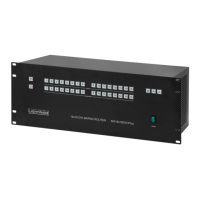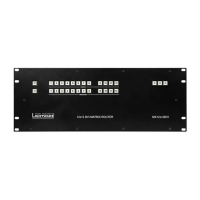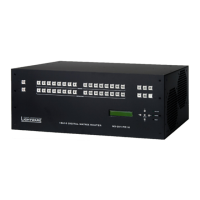Unlocking an Output
Unlocking an output port. The connection on the output can be changed.
Command and Response
{+<<out>•<layer>}
<out2>•<layer>
Example
O1 video output port is unlocked.
INFO: The device issues the response above regardless of the previous state of the output (whether it was
locked or unlocked).
Viewing the Connection State on the Output
Command and Response #crosspoint #switch
<layer>}
<layer>•<O01>•<O02>
Parameters
Parameter Parameter description
<layer> Signal type of the layer
A
audio layer
V
video layer
AV
State letters
State Example
Output is locked
M Output is muted M01
U Output is locked and muted U01
Example
I1 video input port is connected to the O1 video output port; I2 video input port is connected to the O2 video
output port; I2 audio input port is connected to all the audio output ports (O1, O2, O3).
Viewing the Crosspoint Size
Command and Response
<layer>}
•<layer>
Parameters
Parameter Parameter description
<number_of_inputs>x<number_of _outputs>
<layer> Signal type of the layer
A
audio layer
V
video layer
AV
Example
The device has a video crosspoint (4 inputs and 2 outputs) and an audio crosspoint (3 inputs and 3 outputs).
Setting the Video Autoselect Mode
The autoselect mode of the video outputs can be changed.
Command and Response #autoselect
<out>=<state>;<mode>}
<out>=<state>;<mode>
Parameters
Parameter Parameter description
<state> Showing the
Autoselect state
E
autoselect is enabled
D
autoselect is disabled
<mode> The autoselect mode
setting
F
First detect mode
L
P
Priority detect mode
The output port numbers are listed in section.
Example
{as_v1=E;P}
The Autoselect mode of video output 1 and output 2 is enabled and set to Priority mode.
INFO: The Autoselect mode can be queried by typing the {as_v<out>

